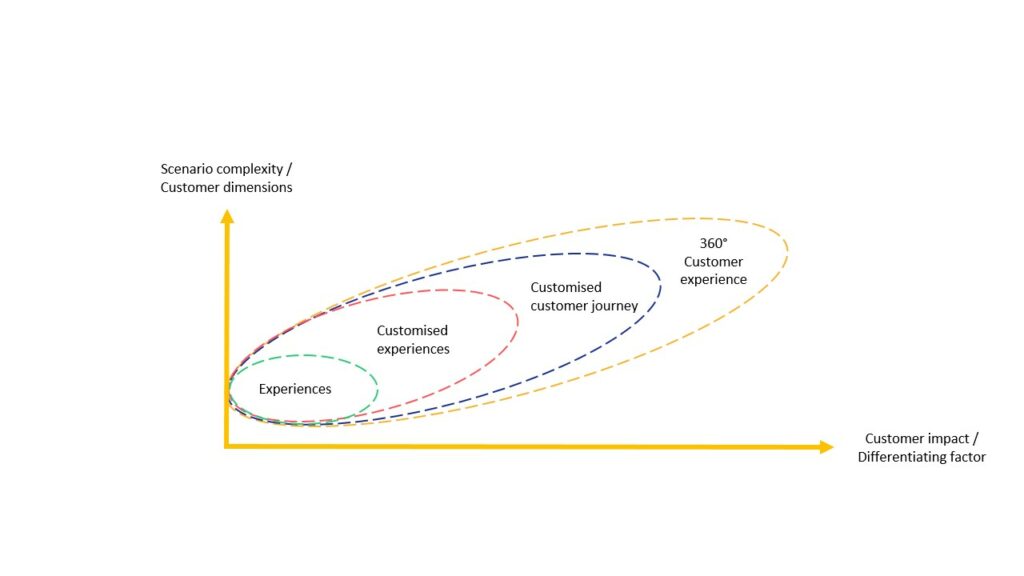In my previous article, I explained that, this year again, we would see a surge in business digitalisation, and that this would accelerate some already observed trends: namely, hyper-automation, AI directly embedded in business processes, Responsive Customer Experience… And I concluded with enterprises’ increasingly high expectations: i.e. support beyond new CRM platform implementation and third-party maintenance. In this second article, I will focus on one technological aspect of this digital transformation: Customer Data Platforms.

Which Customer Data Platform are we talking about?
According to the January 2021 Customer Data Platform Institutereport, CDP platforms can be divided into 4 categories which are increasingly rich in functionality:
- Data-centric platforms, which are mainly used to collect and consolidate Customer data
- Analytics-centric platforms, which are generally used to automate the calculation of Customer aggregates and distribute them
- Marketing Campaigns-centric platforms, that can indicate which customisations to perform for which customer segments
- Delivery-centric platforms, which would include all of the above functions: and more importantly ensure the actual delivery of messages and content
The report’s statistics clearly show that the market is, on the whole, divided in 2:
- With the Data-centric and Analytics-centric platforms on the one side
- And Marketing and Delivery platforms on the other, which in many cases, have been on the market the longest (and are mostly the result of major marketing suites having added CDP modules/functions to their range. However, there are also relatively new solutions that have positioned themselves directly in this segment.).
Data/analytics approach vs Digital/marketing approach
This breakdown is an interesting one as it reflects often heard approaches and speeches. In a nutshell, some advocate for the building of a cross-functional database capable of “breaking silos” and integrating all known customer data, i.e. the data/analytics approach, which generally focuses on the Data Lake-type technical platform.
While others argues for the marketing campaign deployment ease and various other marketing use cases. This is the digital/marketing approach, with a focus on more usability and connectors between the platform and the many marketing/CRM solutions on the market.
Personally, I find the data/analytics approach to be lacking. It is not by building some type of new marketing Datamart, which is even bigger than previous ones, that Customer experience will improve. The automatic consolidation and analysis of anonymous visitors’/customers’ data, regardless of channel, is not the first step: it is the objective.
Why a Customer Data Platform?
In this context of fierce competition and interaction channel proliferation, Marketing teams need to regain control over Customer experiences so they can themselves implement coherent scenarios.
This is why Customer Data Platforms (CDPs) must be user-friendly, and end up acting as smart integration and orchestration platforms for other CRM/Marketing solutions.
Their Customer data activation capabilities are critical:
- Easy management of multiple audiences and scenarios
- Addition/withdrawal of customers in/from marketing scenarios
- Real-time orchestration
- Marketing pressure control
- Customer preferences management, etc.
Customer experience, a matter of perception
According to numerous authors and experts, such as Thierry Spencer or Jon Picoult, Customer experience is the perception created when numerous little thoughtful gestures and details combine together to shape a beautiful story between a brand and its customer. However, these two authors do not only factor in the digital aspect of Customer experience but also integrate all of its human and sensory components. It is what is referred to as “360° Customer Experience” in the diagram below.

Diagram – 360° Customer Experience
The diagram seeks to demonstrate that there are several experience levels which, though increasingly difficult to orchestrate, also escalate in richness and impact on the Customer as we move along the axis. For instance, the first level could be a nice advertising banner pointing to a beautiful landing page, whereas the last level would be attempts to optimise a visitor’s experience upstream, during and after a stay at a Disney resort. It is both digital and physical.
Creating marketing scenarios
I prefer the term marketing scenarios to the term marketing “use cases”: I think that it conveys a brand’s ambition to create rich experiences that have a strong impact on its customers, in short, memorable experiences and an emotional relationship, better.
Each level feeds on the previous experiences, enriches them and builds on them in a succession of thoughtful gestures elaborated upstream and implemented in various scenarios. Let us consider for example a welcome message upon arriving at a luxury hotel. This could be followed by a recommendation to have a free drink at the bar or at the spa if you know that the customer has just had a long trip. A recommendation which can be narrowed down based on the customer’s stated preferences or observed habits.
This simple welcome scenario could thus initially be created using a standard model: this is level one, which though appreciated at first, can rapidly become tiresome if repeated several times in exactly the same way. It should thus be enriched during a second step, for instance by choosing the right channel and recommendation for the customer: this is level 2.
How to choose your Customer Data Platform?
To choose the most suitable CDP for their company, we recommend that customers analyse their needs with respect to the following 7 main themes:
- Upstream channels
- Output channels
- Required level of detail, and required number, of marketing scenarios
- Platform’s level of responsiveness to Customer events (asynchronous, synchronous (5 minutes), real time…)
- Depth of targeting/audience criteria and required customer data preparation upstream
- Marketing department’s degree of autonomy
- Customer path reporting and analysis level
Of course, the point is to not only describe the present; it is important that we plan ahead so that investment in the selected platform becomes future-proof. You should keep in mind a roadmap for all marketing scenarios that you wish to implement within the next 2 years.
From a technical perspective, to meet most of the needs that we would thus identify with the company, the CDP’s connectors with current channels (website, CRM, marketing automation, social media, mobile application…) would be critical: through import, API, third-party integration platform or directly configured connector in the CDP. Indeed, these are the factors that will have an impact on the platform’s response times and the marketing team’s degree of autonomy.
Lastly, for the CDP’s ROI to be apparent, the level of integration between the CDP and the channels must not be seen as an objective: it is a key component that should be present right from the start. This explains the sharp rise in integration platforms, which are extremely popular in digital marketing and with growth hacking experts, as well as the purchase of the CDP Segment by Twilio in November 2020.
The subject of Customer path analysis will be addressed in a future article.
















Your email address is only used by Business & Decision, the controller, to process your request and to send any Business & Decision communication related to your request only. Learn more about managing your data and your rights.